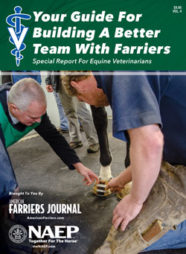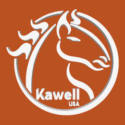By nature of the profession, farriers are susceptible to feelings of isolation. Driving long distances to and from clients every day, sometimes without company and in rural areas, can negatively impact anyone’s mental health.
“Humans are made for and need community,” says Tiffany Gardner, CJF, APF-I, DipWCF. “We need each other, but in today’s world, it’s becoming increasingly difficult to connect with people, to even make the most basic connections.”
Gardner is familiar with the effects of isolation but also how to make choices that foster a positive attitude and build community. At the 2024 International Hoof-Care Summit, Gardner explains that her own isolation was a consequence of her choices and mindset.
Long term, people who are able to forge connections with others, build community support and adopt a growth vs. a fixed mindset will be the most successful in their practice and most fulfilled in their personal lives. Resisting social and physical isolation means choosing to do so each time the opportunity arises. This takes practice and determination, especially in a computer-driven society designed to isolate.
Physical vs. Social Isolation
Physical isolation, being alone or cut off from others, is not always a negative thing, Gardner says. You may be an introvert if you generally prefer your own company to that of others.
“This might represent many farriers, as a lot of us prefer to work in solitude, to get away from the craziness and busyness of our lives,” she says. “The practice of solitude is not the same as physical isolation. Solitude is enjoying your thoughts and company and giving yourself time to reflect. It’s positive, and it’s necessary for creativity and contemplation.”
Too much solitude, however, leads to isolation when it negatively affects mental health. Social isolation has a similar effect on a person’s mental state. This can look like little social contact or support, causing loneliness and a feeling of not belonging, which can lead to physical isolation and vice versa.
“Our minds are our most powerful asset, and we have to take care of them…”
“Regardless of how many clients we may interact with day to day, the boundaries that we need to set with our clients does lead us to have really low interconnectedness,” Gardner says. “At the end of a busy day, you might feel drained. You don’t want to socially connect even with the people who matter.”
Social isolation develops gradually over time, meaning it can be difficult to spot, but it can make you feel anxious and depressed, which leads to low self-esteem. It can also mean feeling panicked about social situations, canceling plans or activities that were once enjoyable and feeling numb or detached, leading to a lack of friends or close coworkers.
Physically, this can cause sleeplessness, reduced immune function, poor cardiovascular health, higher risk of coronary heart disease and stroke, reduced cognitive function, an increased risk of dementia and higher rates of suicide.
Intimate partner violence, loss of loved ones, mental health issues, physical impairments, hearing and vision impairments, social media, unemployment and living in remote locations can all lead to physical and social isolation.
It’s important to keep in mind that mental and physical health are interconnected, so to take care of one means taking care of the other. Gardner cites remote locations, physical impairments and social media as the main causes of isolation in farriers. However, any combination of these can have negative effects.
“Our mental health is not a small matter,” she says. “Our minds are our most powerful asset, and we have to take care of them.”
Choosing Community
Everyone is faced with the choice to isolate or not. Gardner acknowledges that in most circumstances it’s easier to choose isolation. It may be more comfortable, or it’s chosen out of fear.
“Fear has two acronyms: forget everything and run and face everything and rise. How a person chooses to face their fears will directly reflect their mindset,” she says.
Someone with a fixed mindset may be afraid of accountability, judgment or exposure when attending events such as clinics. Others may avoid them because they’re either overconfident or under- confident in their skills. However, isolation may be unintentionally chosen because of social unawareness.
“Being a farrier gives us the freedom to be authentic,” Gardner says. “It’s the beauty of our job. However, you could be alienating yourself from clients and other farriers by choosing to be unaware of how your actions and words affect others.”
When interacting with those who may want community but are unaware of how their behavior is received, Gardner says grace and acceptance toward them are necessary to a certain extent. If you’re on the receiving end of others distancing themselves from you, she advises you to look inward and seek advice from a respected peer or mentor. To grow your business, a level of personal and professional development may need to occur. Communication is a skill that everyone needs to practice and develop.
What Does Community Look Like?
“I truly believe that there is no community out there as powerful and wonderful as the farrier community,” Gardner says. “Farriers band together. We support our own. Our passion connects us. We share because of the others who shared before us. We learn and grow and strive to get better for the horse. We accept each other and find a sense of belonging in a world that we otherwise struggle to find belonging in.”
“There is no community out there as powerful and wonderful as the farrier community…”
Community means support and safety, connection and belonging, as well as learning and acceptance. When part of a community, individuals are more likely to be successful. However, it can be a negative.
“As amazing as our farrier community is as a whole, there is also a very real danger of toxic community mentalities,” she says. “Farriers are passionate individuals, but we do not all practice our crafts the same way. We potentially encounter polarizing viewpoints every day. I’ve seen farriers respond to different opinions with judgment instead of curiosity and open-mindedness. This closes the door to a positive opportunity to build community.”
Resisting Isolation
Part of avoiding isolation is accepting help from others. Whether that means having someone hold you accountable to a routine, to eating healthy or engaging in a fun activity with you. It can all lead to healthy socialization and community building.
Community also necessitates having a growth mindset, meaning you believe your talents and abilities can be developed and improved through hard work, dedication and a willingness to learn from your mistakes, according to Gardner. Like mental and physical health, our choices and our mindset are interconnected. Action and attitude both play a role.
“Believe you can do it,” says Gardner about developing a growth mindset. “Avoid blaming circumstances or others for shortcomings. Be curious. Allow yourself to fail. Leave your comfort zone behind. Emphasize your effort and progress rather than results. Use admiration as a tool. Use other people’s successes to inspire you. Challenge your ego and your limiting beliefs.”
For farriers, building community can mean joining a Facebook group for sharing educational material or a state or national association, which have mission statements and outward focused goals. It’s important to want to contribute to the development and advancement of an organization when joining rather than asking what the organization can do for you.
Setting goals can also help shift you to a growth mindset. This can be setting business development goals, skill development goals, such as forging or tool control, or education goals, such as anatomy or therapeutic shoeing education. By setting goals and creating measurable ways to achieve them, Gardner says you’re more likely to find your tribe of people.
“These are the farriers who understand what it takes to reach that goal you’ve set. They will encourage you, challenge you and support you when you succeed and fail. The common language, mindset and goals brings people together,” she says.
This can also mean joining a competitive team, reaching out to a veterinarian to connect or starting a multi-farrier practice, which Gardner says is not easy because it requires farriers to set aside their egos and be accountable to each other.
“We are all dealing with the same pressures day to day,” she says. “Needy clients, unruly horses, muddy feet, scheduling issues and lameness calls. Simply confiding with a friend between clients can take the pressure off your day and ease the burdens you might feel.”
Calling a peer, mentor, friend or family member rather than texting is a simple act that can pull you out of isolation. These acts must be committed to each day in order to see the effects tomorrow, a month from now or a year from now.
“It’s the sum of our choices that will either lead us toward growth or stagnation, community or isolation,” Gardner says. “We can’t live only for ourselves. A thousand fibers connect us with our fellow men. A farrier in isolation will not survive. Farriers need community. The future of farriery rests on our ability to create that community.”








